
Sea spiders are marine arthropods of the class Pycnogonida, hence they are also called pycnogonids. The class include the only now-living order Pantopoda, alongside a few fossil species which could trace back to the early or mid Paleozoic. They are cosmopolitan, found in oceans around the world. The over 1,300 known species have leg spans ranging from 1 mm (0.04 in) to over 70 cm (2.3 ft). Most are toward the smaller end of this range in relatively shallow depths; however, they can grow to be quite large in Antarctic and deep waters.
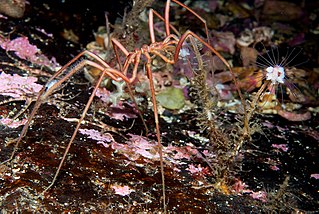
Nymphonidae is a family of sea spiders which has representatives in all the oceans. This family contains some 250 species, most of which are found in the genus Nymphon. Nymphonid bodies are between 1 and 15 mm long, the extent between the points of the legs reaching 150 mm. Most species are predators of hydroids. Like most sea spiders, species in this family have four pairs of legs, except for Pentanymphon antarcticum, which has five pairs, and Sexanymphon mirabilis, which has six pairs.

Hydrometridae is a family of semiaquatic insects, known as marsh treaders or water measurers. They have a characteristic elongated head and body which makes them resemble a yardstick for measuring the water surface.

Notomithrax ursus, known as the hairy seaweed crab, is a spider crab of the family Majidae.

Harpegnathos venator is a species of ant found in South and Southeast Asia in northern India and parts of Burma. Like other ants in the genus Harpegnathos, it jumps to capture prey and lives in relatively small nesting colonies.

Unicorn ("one horn", in Latin) is a genus of goblin spiders from South America, containing seven species that occur predominantly in high elevation, semi-desert regions of Bolivia, Chile, and Argentina. Individuals are relatively large for goblin spiders, measuring up to 3.0 mm (0.12 in) in body length. The genus name refers to a characteristic pointed projection between the eyes and jaws of males. In at least one species, broken-off tips of the male pedipalps have been found within the genitalia of females, postulated as a means of sperm competition. Unicorn possesses several traits that suggest it is a relatively "primitive" member of the Oonopidae, and is classified with other similar, soft-bodied goblin spiders in the subfamily Sulsulinae.
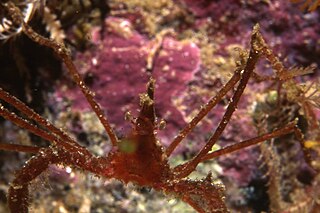
Macropodia falcifera, the Cape long-legged spider crab, is a species of marine crab found around the South African coast. It is a member of the family Inachidae.
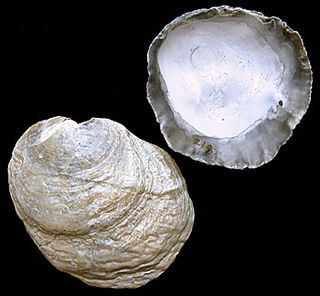
Pododesmus patelliformis, the ribbed saddle-oyster, is a species of bivalve mollusc in the family Anomiidae. It is found in the north east Atlantic Ocean.

Alcyonium digitatum or dead man's fingers is a species of soft coral in the family Alcyoniidae. It is found around the coasts of the northern Atlantic Ocean and other temperate waters such as the South Pacific.

Alcyonium glomeratum or red sea fingers is a species of soft coral in the family Alcyoniidae. It is found around the southern and western coasts of Britain and Ireland.

Oregonia gracilis, commonly known as the graceful decorator crab, is a species of crab belonging to the family Oregoniidae. Like other decorator crabs it habitually attaches other organisms to its back. The sessile organisms are attached to hooked setae that act as a sort of velcro attachment. This decoration provides visual and chemical camouflage thus reducing predation risk. Pacific halibut are a major predator of O. gracilis. Other predators include octopus and sea otters. The main food source of O. gracilis is floating kelp and algae that they capture utilizing a waiting strategy in order to maintain cryptosis.
Palaemonella burnsi is a species of shrimp in the family Palaemonidae, from Maui, Hawaii. This species is closest to Palaemonella lata, which it resembles in the broad scaphocerite in which the lamella overreaches the final tooth, and in the unarmed merus of the second pereiopods. It differs from P. lata in the much longer fused part of the two branches of the upper antennular flagellum, in the relatively much longer fingers and shorter palm of the second legs, in the unarmed carpus of the second legs. It is named after John A. Burns, Governor of Hawaii, for declaring the Ahiki Kinau area a nature reserve.

Nymphon gracile is a species of sea spider first described by William Elford Leach in 1863. The species highly resembles other members of the genus Nymphon, and species identification from morphological traits alone is, therefore, a complex task.

Nymphon leptocheles is a species of sea spider first described by Georg Ossian Sars in 1888. The species greatly resembles other members of the genus Nymphon, and species identification from morphological traits alone is therefore a complex task.
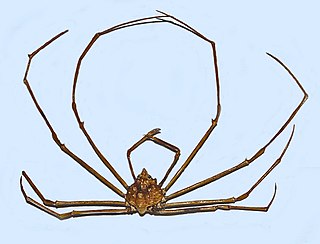
Phalangipus longipes is a species of crabs in the family Epialtidae.

Nymphon signatum, the scarlet sea spider, is a species of sea spider.

Brachyopa flavescens, The Yellow Sapeater, is a fairly common species of syrphid fly. It has been observed in northeastern North America. Hoverflies get their names from the ability to remain nearly motionless while in flight. The adults are also known as flower flies for they are commonly found around and on flowers, from which they get both energy-giving nectar and protein-rich pollen. Larvae for this genus are of the rat-tailed type. B.flavescens larvae have not been described.
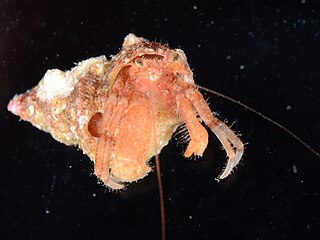
Pagurus dalli, commonly known as the whiteknee hermit or whiteknee hermit crab, is a species of hermit crab in the family Paguridae. It is found in the northeastern Pacific Ocean at depths down to about 276 m (900 ft). It usually lives in a mutualistic symbiosis with a sponge, or sometimes a hydroid.

Pycnogonum litorale is a marine arthropod in the family Pycnogonidae, the sea spiders. It is found in the northern Atlantic Ocean, the North Sea, the English Channel and the western Mediterranean Sea.

















